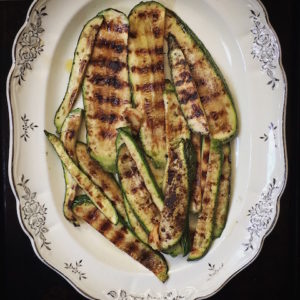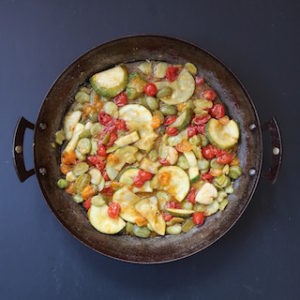Roopa Gulati’s South Indian Rice And Lentil Pulao
Many American readers know Roopa Gulati through Diana Henry’s books. Roopa’s Spicy Scrambled Eggs appear in A Change of Appetite. Her Lemongrass Turmeric Chicken recipe has stained many a copy of A Bird In The Hand. Her Mumbai Toastie recipe, printed in Simple, has acheived cult status. This is what grilled cheese can be if it tries really hard: cheddar cheese seasoned with cumin, coriander, ginger, garlic and lemon juice, served alongside a sprightly chili-cilantro-chutney. An icy beer is recommended. Readers, this one included, swooned.

Now, O happy day: we have a whole book of Roopa Gulati in India: The World Vegetarian.

Cover photography: David Loftus
Divided into small plates, large plates, breads, and relishes, India: The World Vegetarian couldn’t be more timely. Many of us were looking for ways to eat less animal protein before the pandemic hit. With the virus affecting workers in animal processing plants, issues surrounding meat eating have assumed even greater urgency.

—
The pandemic halted any notions of touring. Roopa has instead turned to Instagram, where she’s doing cooking demos. This is perhaps the single instance I can cite of the pandemic contributing to the greater good. I know, that sounds insane. Hear me out. Roopa is a native Brit who spent twenty years living in India. During that time, she worked in Indian television. And it shows: her Instagram demos are polished and professional, yet warm and welcoming. Few people can demonstrate wrapping samosas and dropping them into boiling oil, chatting into the camera all the while without spilling or spattering.

Further, Roopa’s kitchen is nothing fancy–immaculate, sturdy, bare of fancy equipment, it’s the kind of space you can see yourself in. Yes, she has a professional mixer and a heavy chopping board. But Roopa’s kitchen isn’t designed to impress hordes of followers. It’s designed for cooking. Which makes viewers–even viewers like me, with damaged hands and not all that much experience with Indian cuisine–think that they might, just might, be able to have a go at samosas.

Not samosas. Don’t quibble.

Note to would-be cookbook writers: sincerity sells books. It sold India: The World Vegetarian. To me.

—
If you omit hard-boiled eggs from khichdi, or South Indian Rice and Lentil Pulao, your meal will be vegan. Either way, South Indian Rice and Lentil Pulao is vegetarian, gluten free, and kosher. It is also the sort of dish that is naturally all of these things while being itself. It will only improve if made a day ahead, but being a rice dish, it cannot hang around any longer than that. Finishing it up should pose no difficulties.

South Indian Rice And Lentil Pulao with Egg Curry
From India: The World Vegetarian by Roopa Gulati
Recipe courtesy Roopa Gulati
Serves 4 people, or 2 for dinner with leftovers
For the Egg Curry:
2-4 eggs
4 tablespoons canola or sunflower oil
3/4 teaspoon black mustard seeds
approximately 15 fresh curry leaves
1/2 teaspoon dried red chili flakes
2 red onions, diced (see notes)
about 1 ounce/25 grams fresh ginger, peeled and finely diced
1/2 teaspoon ground turmeric
1 pound/400 gram can chopped tomatoes (see notes)
2 green chilis, seeded
2 teaspoons confectioners/baker’s sugar, or to taste
1-2 tablespoons tamarind-see notes
2 tablespoons cilantro, chopped
4 eggs, hard boiled, shelled, and halved (optional but delicious)
For the Rice and Lentils:
8 ounces/200 grams Basmati rice
4 ounces/100 grams red lentils (masoor dal)
6 tablespoons/1/4 cup sunflower or canola oil
1 teaspoon cumin seeds
2 onions, finely sliced
1 ounce/25 grams ginger, peeled and thinly sliced
4 Indian bay leaves or 1.5 inches/4cm cinnamon stick
4 ounces/125 grams frozen peas (see notes)
You’ll need a medium lidded frying or sauté pan and a slightly larger lidded sauté or heavy casserole to make the pulao. I used a 12-inch/30 cm Calphalon 3-quart/3-liter sauté pan and my Staub 14-inch/32 cm 4quart/4liter “everyday” pan, which is enameled cast iron.
Make the egg curry:
Hard boil and shell the eggs. Set them aside.
Roopa calls for sunflower oil, which I am unable to find right now. Canola oil worked well. Pour oil into the smaller pan over medium heat. Add the mustard seeds, allowing them to pop for about 30 seconds. Add the curry leaves, taking care not to burn them. Add the chili flakes and sauté for a few seconds. Add the onion and ginger. Stir.
Cook gently for about ten minutes. Do not let onions brown. Monitor heat, turning it down if necessary.
Add the turmeric, tomato puree, chilis, sugar, and just enough tamarind to give sauce a tart edge. Taste for tart and sweet flavors, adding tamarind and sugar if desired. Remember to wash your hands after handling hot peppers!
Let the sauce simmer on low heat until thickened, 10-15 minutes, then remove the pan from heat.
Make rice and lentil pulao:
Soak the rice and red lentils in a bowl of water for 15 minutes. If you’re a forgetful or distracted type, set a timer.
Heat six tablespoons oil in your larger pot over medium heat. Add cumin seeds and toast until their scent rises, about 30 seconds. Add the onions, ginger, bay leaves or cinnamon stick, and cook for another ten minutes. You want the onions to cook down without browning.
Drain the lentils and rice thoroughly and add them to the pan. Stir to mix.
Pour cold water over all to cover by about one and one half inches, or three centimeters. Reduce heat to low and cover, cooking until liquid is absorbed, 10-12 minutes. Turn heat off and let pulao rest another 10-15 minutes, then stir in the peas. The residual heat should cook them.
Reheat the curry, halve the hard-boiled eggs, and serve. Top the pulao with chopped cilantro, if desired.
Notes:
Roopa uses sunflower oil throughout India: The World Vegetarian I have been unable to get sunflower oil for the past month, and used canola.
Fresh peas are in season right now; if you can find non-starchy peas, use them. If not, this is the rare vegetable that freeze beautifully.
My husband dislikes onions, so I used boiler onions, which are tiny.
Fresh, juicy tomatoes are in season right now, so I used those instead of canned, adding a tablespoon of paste.
If you can find fresh tamarind fruit, it’s ideal. Peel and soften the flesh in boiling water. Otherwise, buy tamarind in blocks. Break a piece off, submerge it in boiling water, and allow it to soak for 20 minutes. Push the cooled tamarind a fine mesh strainer with your clean hands, using the puree. Avoid the stuff sold in jars–it tastes tinny.
I put fresh ginger in sterilized jars filled with rice wine, which helps it keep longer.
I used a small fresh red chili pepper, which was what I had in the house. I seeded it. Be careful when handling hot peppers–don’t touch eyes, mouth, etc.
We had no fresh cilantro in the house, which is why you don’t see it here.
In the spirit of full disclosure, Roopa and I are “friends” on social media, but I wrote this of my own volition, am not being compensated, and bought India: The World Vegetarian with my own money, from Omnivore Books.





